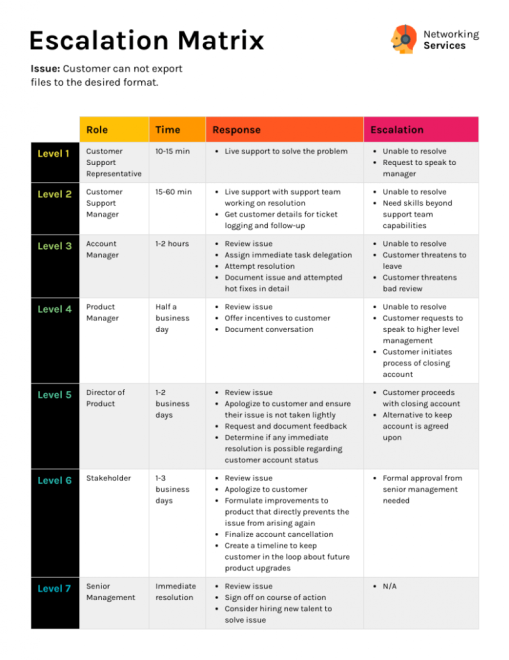Why do you need Customer Service SOPs in your business?
Would you eat in a dirty restaurant? Drive in a car that hadn’t been safety checked? Or buy an appliance that didn’t come with support or a guarantee? Probably not. And neither would your customers.
Your customers want to know that you’ve got them covered.
What are Customer Service SOPs?
Customer service standard operating procedures (SOPs) can be defined as comprehensive guidelines that outline a systematic approach to effectively manage customer relationships.
These SOPs provide a stepwise process for carrying out various tasks essential to customer support, including conflict resolution, inquiry handling, complaint registration, and delivering assistance. Ultimately customer service SOPs act as a valuable resource for managing client relationships.
Creating the perfect customer experience throughout the customer journey is the pinnacle of a modern business approach. The role of your customer service team in this journey is not to be taken for granted. They ensure that your product or service completes and enriches your customer and that the outcomes derived from implementing your solution lead to business success.
Let’s face it, if you drop the ball on this, you will lose customers 🙁, and we don’t want that! That means that your CS team’s product, service, and internal knowledge need te to be up-to-date!
Don’t worry if you’re not there yet.
With our guidelines for Customer Service procedures and processes, we are making sure of just that, and you give your team the right asset to help your customer achieve their desired outcome.

Benefits of a Customer Service SOPs and Process documentation
The importance of SOPs include saving time, operating efficiency and obviously giving customers the very best experience.
Well-written, interactive service procedures;
- Ensure consistency in customer delivery.
- Empower employees with the knowledge needed to deliver on tasks efficiently
- Increase customer satisfaction.
- Increase employee engagement
- Improve contact center metrics, and reduce costs.
- They could be your greatest competitive edge!
The fact is you can’t afford not to focus on customer service nor building a process for customer service.
"Over 80% of customers reported that receiving value during a service experience makes them more likely to repurchase even when given a chance to switch to a competitor." (Hubspot)
Although crafting a Customer Service SOP takes time, you’ll instantly start seeing the results.
How to write Customer Service SOPs
Now you have to dedicate hours to creating Customer Service SOPs?
No.
You can document in no time with tools like Whale.
It’s all about using the right software.
There are options to;
- Use AI-Assist
- Import your current process
- Or simply use a template
When documenting your customer processes, remember to;
1. Listen to your customers
Your customers will tell you when they’re unhappy and what they need if you give them half a chance!
Make a point of meeting customers on a consistent basis to see how your customer service process can be improved.
2. Listen to your team
If you think about it, your internal team members are also your customers.
And they’re the ones who have the closest relationship with external customers.
Make sure to involve them in (or even make them responsible for) creating Customer Service SOPs and processes that create the best outcome and experience for customers.
3. Document ideally in a cloud based easily accessible setting
Ok so you’ve got great customer service SOPs. You’ve worked on them diligently and now they sit on the customer success manager’s computer?
No ❌
These are potentially some of your business’s most important documents and training material.
Make sure every team member can access the latest version in real-time. Choose the best technology – which of course we think is Whale – to make sure your teams are trained and stay up to date.
4. Keep improving and measure progress
Ok so you’ve got great customer service SOPs. You’ve worked on them diligently and now they sit on the customer success manager’s computer?
No ❌
These are potentially some of your business’s most important documents and training material.
Make sure every team member can access the latest version in real-time. Choose the best technology – which of course we think is Whale – to make sure your teams are trained and stay up to date.
3 Customer Service SOPs you need
84% of customers are irritated when agents don’t have the necessary information to sort out an issue.
Make sure your team has the information they need when they need it! And have the basics in place to ensure your team is able to perform at their best as and when needed.
To do this you’re going to need a general customer service process. Just download this template to get you started.
1. Customer Service Level Agreement
If you’re servicing customers, you’re going to need an SLA.
In simple terms, a customer service level agreement (SLA) is a clear and agreed-upon document that outlines the expectations and responsibilities between a service provider and its customers. It serves as a mutual agreement that defines the level of service quality and support the customer can expect to receive.
The SLA typically includes specific details about the services being provided, such as response times, resolution times, availability, and performance metrics. It sets measurable targets and goals that both parties agree to meet. The agreement helps establish a common understanding of what is considered satisfactory service and provides a framework for assessing and improving service delivery.
An SLA gives customers a clear understanding of what they can expect from the service provider. It helps ensure transparency and accountability by specifying the service provider’s responsibilities, such as providing timely responses to inquiries, resolving issues within a certain timeframe, and maintaining a certain level of uptime or availability.
2. Customer FAQs
Customer FAQs are a collection of common questions and their corresponding answers designed to provide quick and accessible information to customers.
"Your FAQ documentation should address the most common questions customers have about your products, services, and brand as a whole. The best way to identify those questions is to tap into your customer service data and see which problems customers are consistently reaching out to you with." (Hubspot)
3. Escalation Process
Your company escalation process should be as smooth and seamless as possible. It’s all about resolving customers’ problems as quickly as possible.
If a problem is not resolved within the first interaction with a customer, you should have an escalation process that details;
- Roles
- Response times
- Targets
- Escalation

Other #musthave Customer Service SOPs
Once you have defined the above elements, you can document things like;
- Specific complaints handling
- The customer service Tone
- The right way to handle a customer crisis
How to measure your Customer Service SOPs?

Calculate your ROI
When you’re choosing a documentation & training solution for your team, you want to know what return you can expect.
Measuring the impact of customer service SOPs can be done through various key performance indicators (KPIs) that assess the effectiveness and efficiency of the implemented procedures. These KPIs may include metrics such as customer satisfaction ratings, response and resolution times, first contact resolution rate, customer retention rate, and the number of escalated issues.
You may also want to consider qualitative data such team feedback and the behavioral impact which is if team members are behaving differently in how they work.
By tracking and analyzing these metrics and forms of feedback, you’ll be able to evaluate the impact of their customer service SOPs on customer satisfaction, operational efficiency, and overall business performance.
It’ll be easy to identify areas for improvement and make data-driven decisions to enhance their customer service processes.
Metrics to measure the benefts of Customer Service SOPs
- Increased speed of Answers 🙋
Rather than having each agent develop their own messaging, answers, and resources to use with customers, give them ready-made content. This enables them to increase their reply speed.
- Reduced call handle time ⌚
Quick access to your team’s frequently recurring questions helps them handle calls better and faster — a win-win for you and your customer.
- Reduce training time 💪
Training new service agents are far quicker and easier when you have clear, explicit explanations of products and security knowledge, support processes, and messaging and troubleshooting info.
- Reduces mistakes 👎
Having your way of work documented leaves less room for error. Everyone knows what is expected of them and how to handle different situations.
Bottom line?
Standard Operating Procedures (SOPs) are vital for ensuring customer consistency, quality, and compliance in various operations across industries. Check out how Whale can assist in creating customer vices SOPs that surprise and delight your customers.
Ready for a digital SOP strategy your Customer Service team will love?
Download our complimentary Ultimate Guide to SOP and Process Documentation below.
FAQs for your Customer Service SOPs
What are the essential elements and parts of a SOP?
Every SOP should comprise of;
- Purpose and Scope: This section outlines the SOP’s objectives and the operations it covers, explaining why the procedure is necessary and who it applies to.
- Glossary or Definitions: It provides definitions for terms and acronyms used within the SOP to ensure clarity and understanding among all users.
- Procedure: The core section detailing the step-by-step instructions necessary to perform the tasks or processes covered by the SOP. This part should be clear and detailed enough for someone with the requisite skills to follow without prior experience.
- Roles and Responsibilities: Identifies the individuals or groups responsible for carrying out specific tasks within the procedure, ensuring accountability and clarity in execution.
Who Should Write SOPs?
SOPs should be written by individuals who have a deep understanding of the processes and tasks at hand, typically involving collaboration between:
- Subject Matter Experts (SMEs): Individuals with specialized knowledge or expertise in the process being documented.
- AI! You can even get AI to write your SOPs. Simply choose the AI Assist tool in Whale.
- Operational Staff: Employees who perform the tasks daily can provide practical insights into the workflow and identify common issues or bottlenecks.
- Quality Assurance Personnel: Ensures the SOP meets the required standards and complies with regulatory requirements.
- Management: Provides oversight to ensure the SOP aligns with organizational goals and policies.
Involving a cross-functional team in the SOP writing process helps ensure the document is comprehensive, accurate, and practical for end-users.
Ultimate Guide to SOP & Process Documentation
The why, what, and how to unlock the next level of growth in your business with SOPS & systems
Bram Billiet
Posts you might like

The Best Scribe Alternatives for Recording
Scribe is a good step recording software but you may want to consider alternatives because it’s pretty expensive for what you get. Let’s look at the best Scribe alternatives available and what each one offers.

Knowledge Transfer is Your Business’s Muscle for Growth ?
Knowledge transfer is key!
The stronger your knowledge ‘position’ within your organization, the greater your propensity to grow.
We recently spoke to process consultant, Founder and CEO of Business Success Consulting Group, Adi Klevit to get her thoughts on why knowledge transfer matters.

From 15 to 30 Employees with Transparent Processes
Want to scale quickly and in a way that employees will actually thank you for? Follow this CEO’s journey in utilising transparent processes that resulted in systemization, centralization and scaling.







